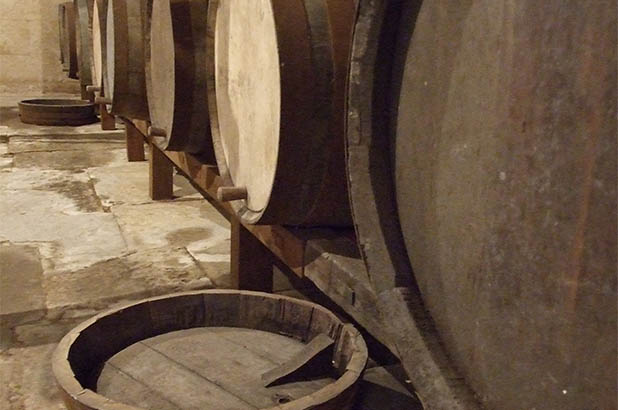
In the cellars at Elizabeth Bay House.伊丽莎白湾别墅的地窖 Photo Scott Hill © SLM
One of Elizabeth Bay House’s most evocative spaces is its wine cellar, built under the mud-stone floor of the entry hall and saloon. Faint impressions of painted labels – sauternes, Teneriffe, port, claret, sherry, brandy, are still evident on the arched storage bays designed to hold casks and bottles. The wine cellars were connected to the house with an internal staircase, giving the butler – who was entrusted with the keys – access to the wine store.
伊丽莎白湾别墅最令人回味的空间之一是酒窖,它建在入口大厅和客厅的泥石地板下。在拱形的储藏槽上,还可以看到淡淡的彩绘标签印记--苏玳、特纳里夫、波特、克拉雷特、雪利酒、白兰地,这些标签是专门用来存放酒桶和酒瓶的。酒窖通过内部楼梯与房屋相连,管家可以通过钥匙进入酒窖。
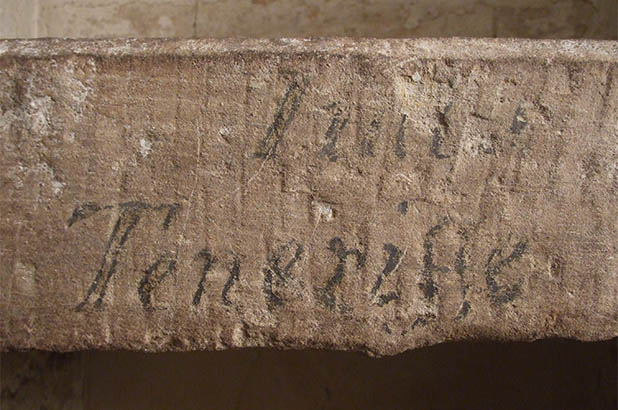
Painted label for ‘Teneriffe’ in the cellars at Elizabeth Bay House. 伊丽莎白湾别墅酒窖中 "特纳里夫 "的彩绘标签。Photo Scott Hill © SLM
Wine and ‘sobriety’
葡萄酒与 "清醒
Wines were imported from Europe, the Canary Islands, and from the Dutch colony at the Cape of Good Hope – sweet Constantia being its specialty. Wine grapes were planted in Sydney by Governor Phillip in 1788, and other settlers experimented with wine growing in, most notably Philip Schaeffer, Gregory Blaxland and the Macarthurs, who were the first to find real success in wine making. Local wine quality was questionable, and alcohol content tended to be very high, sometimes because brandy was added to help their keeping quality. But as the 19th century progressed, wine drinking was encouraged as the government advocated ‘sobriety’ – which did not necessarily mean abstinence, but a more responsible drinking culture – a call we hear still today. Wine was seen as a preferential alcohol to the customary spirits and strong ales still favoured by most of the population.
葡萄酒从欧洲、加那利群岛和荷兰好望角殖民地进口,康斯坦丁甜葡萄酒是其特产。1788 年,菲利普总督在悉尼种植了酿酒葡萄,其他定居者也在悉尼尝试种植葡萄酒,其中最著名的是菲利普-谢弗(Philip Schaeffer)、格雷戈里-布莱克斯兰(Gregory Blaxland)和麦卡瑟家族(Macarthurs),他们是第一个在葡萄酒酿造方面取得真正成功的人。当地葡萄酒的质量很成问题,酒精含量往往很高,有时是由于添加了白兰地以帮助保持质量。但随着 19 世纪的发展,政府提倡 "清醒"--这并不一定意味着禁酒,而是一种更负责任的饮酒文化--我们今天仍能听到这样的呼声,鼓励人们饮用葡萄酒。相对于大多数人仍然喜爱的烈性酒和烈性啤酒,葡萄酒被视为一种更受欢迎的酒类。
A health tonic
健康补品
Wine was being promoted for its health benefits and many ‘wine doctors’ had interests in wine production – starting with Dr Redfern who established a wine-producing vineyard in NSW in 1818, purporting wine as a malnutrition and scurvy deterrent. Prescribing a pint of wine per day for transported convicts would surely have helped develop his business model (?!!). Drs Lindeman (Carwarra, Hunter Valley c1850s), and Angove (Maclaren Vale South Australia, 1886) whose brand names are still marketed today, followed this trend. Physician and health reformer Philip Muskett had much to say about the merits of Australian wines and the need for styles lighter in character and in alcohol content, in his prescient treatise The Art of Living in Australia, first published in 1893. It took almost 100 years for Australians to heed his advice.
葡萄酒因其对健康的益处而得到推广,许多 "葡萄酒医生 "都对葡萄酒生产感兴趣--首先是雷德芬医生,他于 1818 年在新南威尔士州建立了一个酿酒葡萄园,声称葡萄酒可以预防营养不良和坏血病。每天为被押送的囚犯提供一品脱葡萄酒的处方肯定有助于发展他的商业模式(?) 林德曼医生(Carwarra,猎人谷,约 18 世纪 50 年代)和安戈维医生(Maclaren Vale,南澳大利亚,1886 年)紧随这一潮流,他们的品牌至今仍在市场上销售。医生和健康改革家菲利普-马斯基特(Philip Muskett)在他于 1893 年首次出版的先知先觉的论文《澳大利亚生活的艺术》(The Art of Living in Australia)中,对澳大利亚葡萄酒的优点和对淡雅风格和酒精含量的需求有很多论述。近 100 年后,澳大利亚人才听取了他的建议。
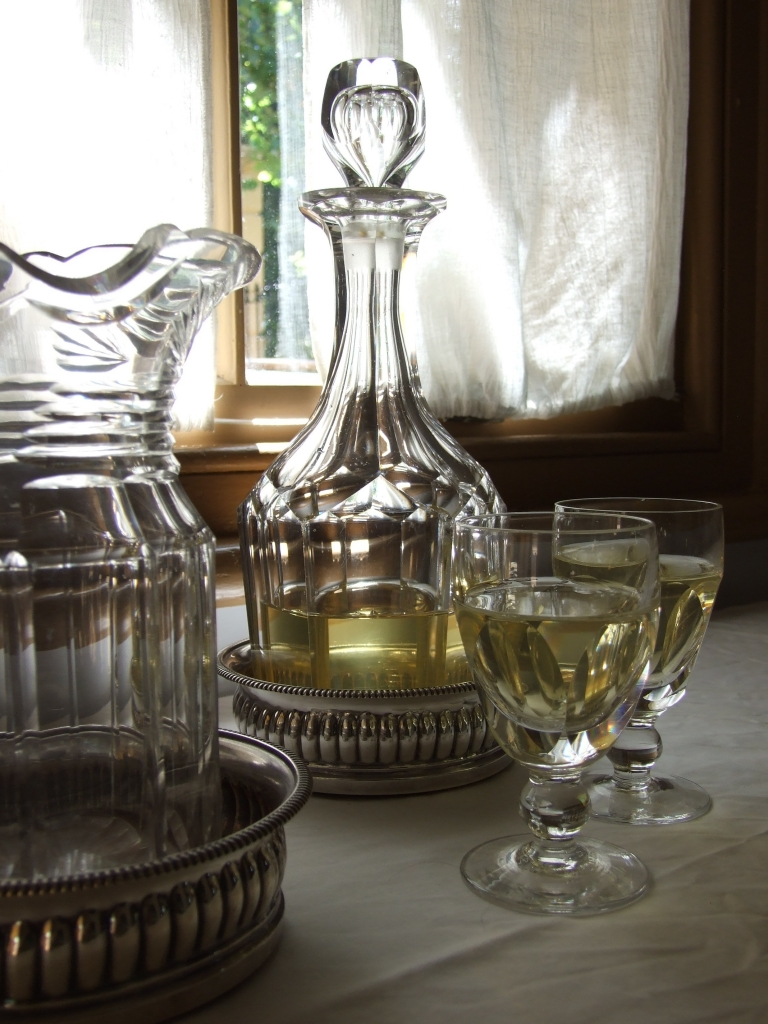
Wine decanters and glasses.醒酒器和酒杯 Photo Scott Hill © SLM
Colonial tastes
殖民口味
Tastes in wine seem to have been much sweeter in the 19th century, and higher in alcohol than we expect today. Fortified wines such as sherry, port, sauternes and toquay style wines were very much in favour. If you are wanting to host a colonial style or period dinner, Shiraz, Cabernet Sauvignon (claret) or other blended style reds would be suitable. Reisling, Verdhello and sweeter Muscat or German style whites (commonly referred to as ‘hock’, short for Hockheimer), style wines would be appropriate whites for the table. Sherry would be served before dinner or at the table with the soup, proceeding onto other table wines with more substantial dishes. Champagne might be served with desserts (what we’d now regard as the cheese course), and for toasts, and port and brandy to linger at the table with.
19 世纪的葡萄酒口味似乎更甜美,酒精含量也比我们今天所期望的要高。雪利酒、波特酒、苏玳酒和托卡伊葡萄酒等加强型葡萄酒大受欢迎。如果您想举办殖民风格或时代风格的晚宴,设拉子、赤霞珠或其他混合风格的红葡萄酒都很适合。Reisling、Verdhello 和较甜的 Muscat 或德国风格的白葡萄酒(通常称为 "hock",是 Hockheimer 的缩写)则适合作为餐桌上的白葡萄酒。雪利酒可在餐前饮用,或在餐桌上与汤一起饮用,然后再与其他佐餐酒一起搭配更丰盛的菜肴。香槟酒可以搭配甜点(我们现在称之为奶酪菜)和祝酒词,波特酒和白兰地则可以在餐桌上享用。
The Macleays and wine
麦克莱家族与葡萄酒
The Macleays were early colonial wine growers, establishing vineyards at their property Brownlow Hill in Camden in the 1830s, not far from the Macarthur family’s Camden Park estate. The Macleay family had quite a history with wine – Alexander Macleay’s first job, aged 19, was with a wine merchant in London, William Sharp in 1786. Sharp must have made a strong impression on him, as the Macleays named their eldest son William Sharp Macleay (b.1792). The cellars, integral to the design of Elizabeth Bay House, stand testament to Alexander’s interest in wine, even if only for his own consumption! William Sharp Macleay lived at Elizabeth Bay house from 1845, no doubt enjoying the benefits of his own wine stores, until he died in 1865. The house was then passed on to another William – Sir William John Macleay, renowned natural scientist (founder of the Macleay museum at the University of Sydney), politician and winemaker.
麦克莱家族是早期的殖民地葡萄酒种植者,19 世纪 30 年代,他们在卡姆登的布朗罗山庄园建立了葡萄园,距离麦克阿瑟家族的卡姆登公园庄园不远。麦克莱家族与葡萄酒颇有渊源--1786 年,19 岁的亚历山大-麦克莱的第一份工作是在伦敦的葡萄酒商威廉-夏普(William Sharp)那里。夏普一定给他留下了深刻的印象,因为麦克莱家族给他们的长子取名为威廉-夏普-麦克莱(William Sharp Macleay,生于 1792 年)。酒窖是伊丽莎白湾别墅设计中不可或缺的一部分,它证明了亚历山大对葡萄酒的兴趣,即使只是为了自己饮用!威廉-夏普-麦克莱从 1845 年起一直住在伊丽莎白湾别墅,毫无疑问,他一直享受着自己酒窖的好处,直到 1865 年去世。之后,这座房子又传给了另一位威廉--威廉-约翰-麦克莱爵士,他是著名的自然科学家(悉尼大学麦克莱博物馆的创始人)、政治家和酿酒师。
Wolonjerie ,1878 年 7 月 30 日,第 4 页。
WOLONJERIE WINES
沃隆杰里葡萄酒
Sir William produced wine from his property on Lake Albert in Wagga Wagga, in south-western NSW, under the ‘Wolonjerie’ label. His 33 acres under vine at Wolonjerie resulted in (using the contemporaneous spelling) Scyraz (shiraz), Verdilho, Riesling and blended wines (Malbec, Goreais, Aucarot). The wines were made and blended at the vineyard, then transported to Sydney in oak barrels by ox-cart. It’s not surprising that as the district’s member on the Legislative Council, William was instrumental in extending the NSW railway system to Wagga!
威廉爵士在新南威尔士州西南部瓦加瓦加阿尔伯特湖畔的庄园酿造葡萄酒,并贴上 "Wolonjerie "标签。他在 Wolonjerie 种植了 33 英亩的葡萄树,酿造出(使用当时的拼写)Scyraz(设拉子)、Verdilho、雷司令和混合葡萄酒(马尔贝克、戈雷斯、奥卡洛)。这些葡萄酒在葡萄园酿造和调配,然后用牛车装在橡木桶里运往悉尼。作为该地区的立法委员会成员,威廉在新南威尔士州铁路系统延伸至瓦加的过程中发挥了重要作用,这也就不足为奇了!
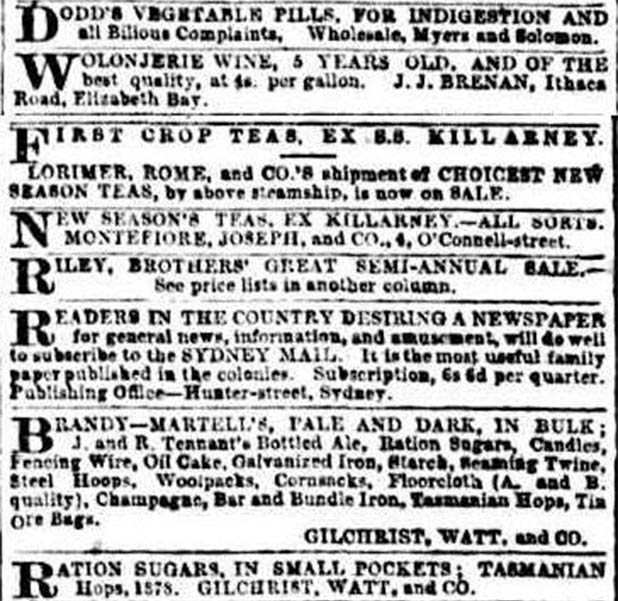
Advertisement for Wolonjerie wine, The Sydney Morning Herald, 葡萄酒广告,《悉尼先驱晨报》30 July 1878, p 4.
Retrieved 15 July 2013 from
http://trove.nla.gov.au/ndp/del/article/13413790
The oak barrels stored in the cask room under Elizabeth Bay House, and William employed cellar-men to bottle the wine and distributed his wines from there. Wolonjerie wines were advertised in Sydney and district newspapers, and found a ready market in ships passing through Sydney, convincing their captains of the merits of his wines. The bottling and distribution operation out-grew the undercroft cellars at Elizabeth Bay House and he commissioned a purpose built iron cellar on the estate, on Ithaca Road, at the cost of £200 which unfortunately, has not survived. William used his social standing to get personal endorsement from the Governor of NSW, entered his wines in the Great Exhibition in 1879. Not only did he display his wines, William sold them to the Exhibition caterers – astute businessman! He served his Wolonjerie wines to the many eminent guests at dinners held here, and at his home in Elizabeth Bay, making tasting notes in his diaries.
橡木桶存放在伊丽莎白湾宅邸下的酒窖里,威廉雇用酒窖工人将葡萄酒装瓶,并在那里销售葡萄酒。Wolonjerie 的葡萄酒在悉尼和该地区的报纸上刊登广告,并在途经悉尼的船只上找到了现成的市场,使这些船只的船长相信了他的葡萄酒的优点。装瓶和分销业务的发展超出了伊丽莎白湾庄园的地下室酒窖,于是他花了 200 英镑在伊萨卡路的庄园里专门建造了一个铁制酒窖,遗憾的是,这个酒窖已经不复存在了。威廉利用自己的社会地位获得了新南威尔士州州长的亲自认可,并将他的葡萄酒参加了 1879 年的大博览会。威廉不仅展出了自己的葡萄酒,还将它们卖给了展览会的餐饮业者--一位精明的商人!在这里和伊丽莎白湾的家中举行的晚宴上,他为众多贵宾提供沃隆杰里葡萄酒,并在日记中记录下品酒笔记。
The cellars beneath the house remain on view and are occasionally used as a venue for wine tastings and functions, and even weddings!
房子下面的酒窖仍在使用,偶尔也作为品酒会、活动甚至婚礼的场所!
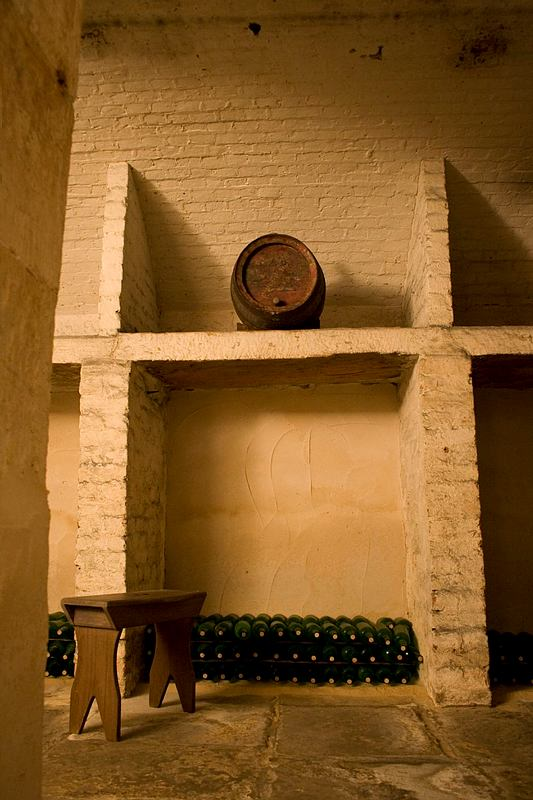
Cellars at Elizabeth Bay House. 伊丽莎白湾别墅的酒窖Photo © Leo Rocker

